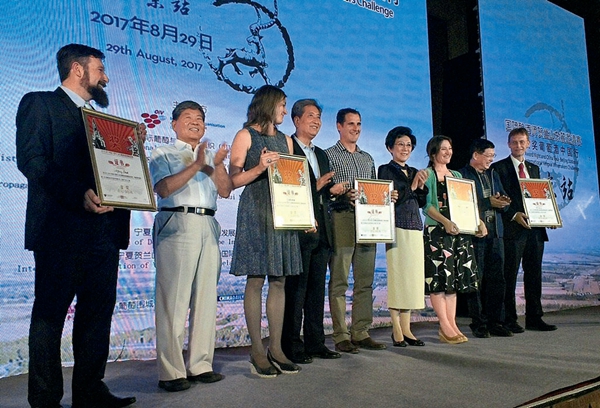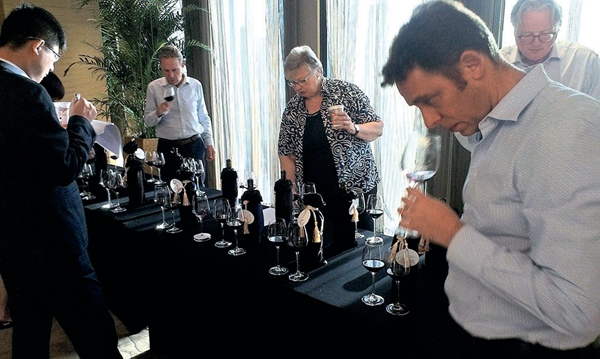Ningxia Winemakers’ Challenge: Flushed with Success
China Today by Jacques Fourrier,January 08, 2018 Adjust font size:
Unprecedented Challenge
Within less than a decade, what used to be a barren stretch of land in a remote corner of China’s northwest region is now the talk of the town in the Chinese wine industry and one of the best-kept secrets amongst foreign wine experts.
“The Chinese central government began to earmark winemaking as a ‘key industry’ in 2010. The message was clear – authorities at all levels should spare no efforts to boost this sector, the ultimate goal being the creation of an industry heavyweight,” said Feng Jianjun, deputy director of Ningxia’s Helan Mountain Grape Industry Development Bureau.

The five gold medal winners at the NWC 2017 in Beijing on August 29, 2017.
Thanks to a battery of incentives and a favorable policy of land reclamation, private investors, industry moguls, and entrepreneurs alike threw themselves into winemaking. It was a turning point for Helan Mountain’s East Foothill and the landscape changed completely. This defining moment is best epitomized by the flurry of mock-Renaissance castles (the most iconic examples being Chateau Changyu Moser XV, Helan Ting Winery, Chateau Saint Louis Ding, and Chateau Mihope), sharp-angled modernist edifices (modern architecture buffs would squeal with delight at the sight of Chateau Yunmo Great Wall or Chateau Shapotou), and dozens of more run-of-the-mill, traditional wineries strewn across the region.
This strategy paid off. In 2011, the Helan Qingxue Vineyard, a quaint 23-hectare estate founded in 2005, with a stunning view of the Helan Mountain, snatched the first Chinese gold medal awarded by Decanter, the world’s leading wine magazine.
There are now 187 wineries on Helan Mountain’s East Foothill’s 124-mile long, 51,000-mu (35,333 hectares) stretch of vineyards. The region needs a narrative for its wines, one that includes prestige, tradition, quality... and good value for the consumer’s money. Even though Bordeaux is seen as the archetypal example, Napa Valley in California or Barossa Valley in South Australia has provided templates for the ideal combination of wine and tourism, or “enotourism” as it is called.
The Ningxia Winemakers Challenge (NWC) was designed to provide a much-needed positive narrative for the region. On July 13, 2012, the first edition was launched. A total of seven winemakers from all over the world began to try their hands at making wines. Two years later, on September 25, 2014, a contest was held in Beijing and prominent media organizations such as the BBC, The Wall Street Journal, and CCTV reported the news. David Tyney, a young winemaker from Australia paired with Chateau Yuhuang, was the absolute winner.

The panel during the second round of tasting. Photos by Jim Boyce
“The Ningxia Winemakers Challenge is not a wine challenge, it’s a communication challenge,” remarked Jim Boyce, founder of grapewallofchina.com, who helped the International Federation of Vine and Wine of Helan Mountain’s East Foothill and Ningxia’s Bureau of Grape Industry Development organize the challenge.
The success of the second edition is a testament to the region’s reputation on a grander scale. This time, 48 candidates were paired with a winery, received a three-hectare parcel of grapes in a collective 18-year-old vineyard, and made a Cabernet. Most of the winemakers, hailing from 17 countries – Australia, Argentina, Italy, India, South Africa, Sweden, etc. – returned at least once to check their creations. Candidates found themselves in wildly different situations as partner wineries ranged in expertise from wily veterans to total newbies, in size from small and family-owned to huge and state-owned entities, in equipment from having top-of-the-range technology to needing to improvise, and in location from the outskirts of Ningxia’s capital Yinchuan to more than 100 kilometers away. Grape quality also significantly differed, with the 2015 fruit far superior to that of 2012, thus raising the potential for impressive wines.